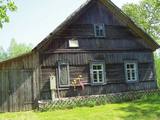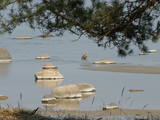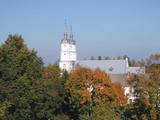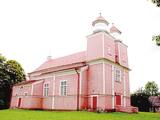| Nr | Name | Beschreibung |
|---|---|---|
|
Darbnīcā tiek izgatavoti personalizēti pulksteņi un dažādi dizaina priekšmeti no koka, kā arī piedāvātas kokapstrādes meistarklases vai klātbūšana dažādos materiāla pirmsapstrādes vai finiša apstrādes procesos. Tāpat iespējama ekskursija pa darbnīcu un koku sugu atpazīšanas viktorīna. |
||
|
The Priekule Lutheran Church was built around 1680 and rebuilt a century later, in 1892. In 2005, the church tower was improved, and visitors to the church can now use it as a viewing platform. They can see the place where Icarus of Priekule supposedly made his first “flight.” |
||
|
Ezeres kultūrvēstures un novadpētniecības materiālu krātuve “Muitas nams” ir izveidota vēsturiski nozīmīgā ēkā, kur, II pasaules kara noslēgumam tuvojoties, 1945. gada 8. maijā tika parakstīts Kurzemes katlā ielenkto vācu karaspēka daļu kapitulācijas akts. Ar to tiek uzskatīts, ka Ezerē faktiski beidzies II pasaules karš. Krātuves materiālu ekspozīcijas ir no Ezeres pagasta senvēstures līdz šodienai, tai skaitā ezernieku vaļasprieki. |
||
|
Eine alte Ortschaft. In den 30er Jahren des 20. Jh. gab es hier 50 Bauernhöfe, aber im Jahr 1990 nur noch zehn. In Oviši ist der Wissenschaftler livischer Herkunft; der Entomologe Kārlis Princis (1893–1978) geboren, der 1944 nach Schweden ausreiste. Oviši Leuchtturm (1814) ist der älteste immer noch funktionierende Leuchtturm in Lettland mit einer Höhe von 38 m. Von hier oben bietet sich eine herrliche Aussicht. Das Personalgebäude des Leuchtturms wurde 1905 erbaut und war einst der Bahnhof der Schmalspurbahn. Im Nebengebäude wurde das Museum des Oviši Leuchtturms eingerichtet. In der Nähe des Leuchtturms befindet sich das Kunstobjekt Austra-Baum aus Metall. Dem Kap Oviši gegnüber ist ein guter Ort zurVogelbeobachtung. |
||
|
The House-Museum of the writer Michael Narics. Reveal the history of political repressions in the
USSR and Soviet Latvia; see creative works of the winners of competition organized by M. Narics Educational
Center.
Working hours: on request |
||
|
Im Garten „Bānīši“ wachsen Schwarze Johannisbeeren auf über 3 ha. Die Inhaberin dieses Hofs wendet dabei schon seit Jahren die im Ausland populäre Methode an, dass die Kunden die gewünschte Menge selbst pflücken |
||
|
Divus kilometrus garās lokveida takas sākums ir meklējams pie Somā nacionālā parka apmeklētāju centra (atklāts 2000. gadā) – Tēramā ciemā. Tā ved gar Mardu strauta (Mardu oja) krastu, kur krustām šķērsām ir sakrituši bebru nogāztie koki, radot diezgan juceklīgu skatu. Apmeklētāju centrā var iegūt nepieciešamo informāciju, noskatīties videofilmu un nacionālajam parkam veltītu ekspozīciju. |
||
|
Grūti iedomāties, ka vēl joprojām Eiropā ir apdzīvotas vietas, kuru sasniegšanai ir labu laika sprīdi jābrauc pa neapdzīvotu mežu ieskautu smilšainu ceļu, kur tikai paretam var redzēt kādu sēņotāju vai ogotāju! Tāpat kā Zervinos ciemam, arī šim ir piešķirts kultūras mantojuma pieminekļa statuss, jo Linežeris ir viens no dažiem nacionālā parka etnogrāfiskajiem ciemiem. Linežerī ir aplūkojamas 19. – 20. gs. mijā celtās ēkas un apskatāms tā laika ciema plānojums. Šejieniešu tāpat kā citu dzūku galvenā nodarbošanās bija mežistrāde un meža velšu vākšana. Nelielā mērā – arī lauksaimniecība. Apceļojot nacionālā parka etnogrāfiskos ciemus, rodas pamatots jautājums: „Ar ko mūsdienās te nodarbojas cilvēki. Kā viņi spēj dzīvot tik nomaļā vietā”? Jāatzīst, ka lielākā daļa te ierodas tikai vasaras laikā. Neskatoties uz to, etnogrāfiskie ciemi ir ļoti sakopti un joprojām „dzīvi”! |
||
|
Ein neues Cafe, das sich auf dem Gelände des Naturparks „Daugavas loki” in Naujene befindet. |
||
|
Lai arī dievnama pirmsākumi meklējami 18. gs. sākumā, tā celtniecību (arhitekts Johanns Eduards de Vite) pabeidza viena gada laikā 1834. – 1835. g. (vēlīnā klasicisma stils). Būvniecības darbus finansēja Krievijas cars. Gan baznīcas atrašanās piejūrā, gan arī tās nosaukums liecina, ka tā celta, godinot Svēto Nikolaju, kas ir visu jūrnieku un zvejnieku aizbildnis. Baznīca apskatāma arī no iekšpuses, kur uzmanība jāpievērš ērģelēm un altārgleznai (1888. g.). |
||
|
Die westliche Küste der Rigaer Bucht ist das ganze Jahr über ein wichtiger Zufluchts- und Nahrungsort für viele migrierende Vögel. Von den geschützten Vogelarten begegnet man hier am meisten dem Sterntaucher und dem Prachttaucher, der Brandgans, der Eisente und der Zwergmöwe. Das Gebiet ist auch sehr wichtig für den Schutz der Riffe. Es befindet sich gegenüber der Regionen Dundaga, Roja und Engure, sowie der Stadt Jūrmala. Die Fläche beträgt 132 173 ha. Das Territorium enthält den Meeresteil vom Naturpark „Engure“ und dem Nationalpark von Ķemeri.
|
||
|
Die Gastgeberin des Strandhauses Tahku organisiert Workshops zum Marinieren und Einlegen von Gurken. Dabei herrscht eine fröhliche Atmosphäre. Das Gurkenfest Tahkuranna findet jedes Jahr am 20. August statt. Man kann dort auch Gurkenkonserve, lokale Lebensmittelprodukte und Handwerkserzeugnisse kaufen sowie Handwerkserzeugnisse selbst herstellen. |
||
|
Eine erste Holzkirche wurde an dieser Stelle1252 errichtet, ein steinernes Gotteshaus wurde 1665 erbaut. Diese fiel einem Brand zum Opfer, wurde aber 1672 erneuert, in späteren Jahren auch umgebaut. Bedeutende Baudenkmäler zieren das Interieur des Gotteshauses – ein Altar, eine Kanzel, eine Orgel mit Malereien auf dem Prospekt und dem Balkon. In der Kirche ist der legendäre Herzog Jakob Kettler getauft, hier heiratete er Prinzessin Charlotte Luise von Brandenburg. In der Sowjetzeit wurde die Kirche nur als Museum und Konzertsaal genutzt. Der Legende nach hat die Kirche ihren Namen nach einer gewissen Katharina erhalten, die Spenden für den Bau der Kirche gegeben habe, dann verleumdet und zum Tod auf dem Folterrad verurteilt worden sei und später heilig gesprochen wurde. Zu ihrem Gedenken gibt es über dem Seiteneingang der Kirche ein Medallion, mit ihrem Abbild mit Märtyrerkrone, dem Folterrad und einem Schwert in der Hand. Motive dieser Legende sind auch im Wappen der Stadt Kuldiga zu erkennen. Vom Kirchturm hat man einen guten Blick auf die Ziegeldächer der Altstadt. |
||
|
Tāšu – Padures muiža (Tasch – Paddern) celta 19. gs. sākumā kā Korfu dzimtas pils, kas 1852. gadā pāriet Keizerlingu dzimtas īpašumā kā medību pils, kas kalpojusi kā vasaras mītne, un ir izcils vēlīnā klasicisma paraugs. Iekštelpās saglabājušies vairāki senā interjera apdares fragmenti. Pēc pils pabeigšanas, ap to sāka veidot vairāk kā 10 ha lielu parku ar svešzemju kokiem. Šobrīd muižas ēkā atrodas Kalvenes pamatskola. |
||
|
Uzcelts Kaņiera pilskalnā un ir Kaņiera pilskalna takas sastāvdaļa. No torņa paveras izcila Kaņiera ezera dienvidrietumu daļas ainava ar niedru saliņām un nelieliem atklāta ūdens laukumiem. Laba putnu vērošanas vieta. |
||
|
The farmstead grows apples, strawberries, black currants, red currants, etc., berries and fruits; there is a big selection of processed goods: natural juices, nectars and syrups. There are offered apple, strawberry, red currant, gooseberry, sea-buckthorn and chokeberry saplings; consultations are given for making out a commercial garden and taking care of it. Excursions around the commercially grown plants. |
||
|
St. Michael the Archangel Roman Catholic Church of Viļāni. The Church together with the Monastery
of Bernardian Order was built in the middle of the 18th century. It is a national cultural monument. Many
important paintings, sculptures and objects of applied arts have survived here. The Church has an organ and
a fisharmony. The status of national importance was awarded to the architectural monument in 1952.
|
||
|
Ein ausgezeichneter Sandsteinaufschluss, der sich am rechten Uferhang der Gauja versteckt und eine Höhe von 15 m erreicht. Der Aufschluss wurde von einer wilden Bienenart durchlöchert, die kleine Höhlen in den Sandstein gebohrt haben, in denen sich ihre Larven entwickeln. Es wurde ein gut ausgestatteter Pfad mit Treppen angelegt. Die Objekte liegen im Nationalpark Gauja.
|
||
|
Befindet sich im Südteil der Siedlung Feimaņi. Die Kirche wurde von 1756 bis 1760 gebaut. Feimaņi war ein Eigentum der Baronengeschlecht von Korff. Die Kirche gehörte verschiedenen Konfessionen gemäß dem Religionswechsel der Baronen von Korff vom Luthertum zum Katholizismus. Es lohnt sich zu erwähnen, dass die katholische Kirche in Feimaņi sich zwischen den Kirchen im Bezirk Rēzekne durch größte Anzahl der Kunstdenkmäler von staatlicher Bedeutung auszeichnet. Darunter sind eine Beichtbank, Kirchenbänke, einen Orgelprospekt, Silberbecher und fünfzehn Holzschnitzereien des Altars, darunter drei aus dem 18. Jahrhundert zu erwähnen. Bei den Kirchentoren erhebt sich einen Glockenturm mit vier Glocken. Während der Karwoche werden in der Kirche anstatt der Glocken die s.g. “Klappern” verwendet. Die sind 2 m lange un1 m hohe Gegenstände, die an altertümliche Wäschemängel erinnern. In Feimaņi befindet sich eine der drei Fahnenherstellungswerkstätten Lettlands, die mit den modernsten Einrichtungen im Baltikum ausgestattet ist. An diesem Ort wurde sowohl ideologisch als auch physikalisch die Fahne Lettgallens “geboren”. |
||
|
Atrodas Valmieras – Ainažu autoceļa (P 16) malā starp Matīšiem un Aloju. Iekārtota vecajā un atjaunotajā dzirnavu ēkā. Nedēļas nogalēs piedāvā izklaides pasākumus, klāj galdus un īrē telpas svinībām. |
||






















